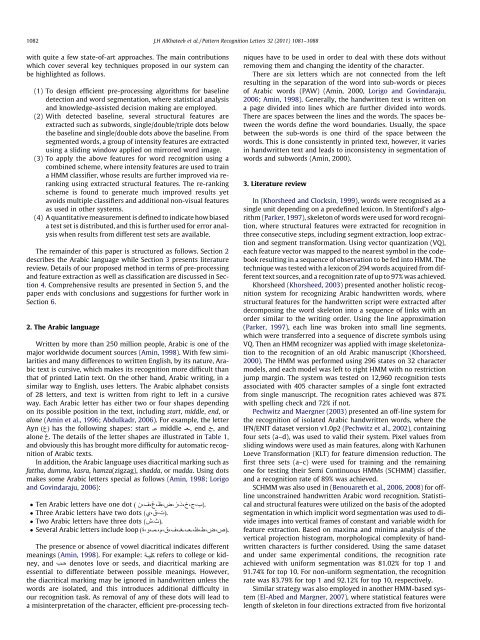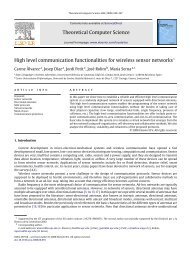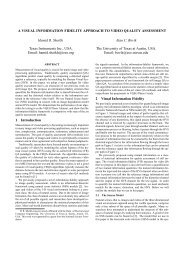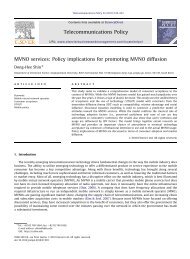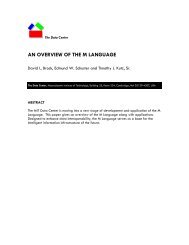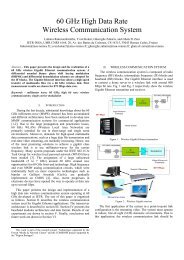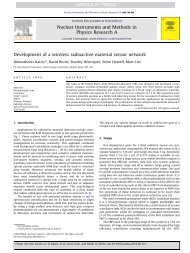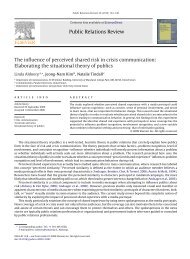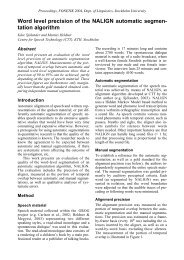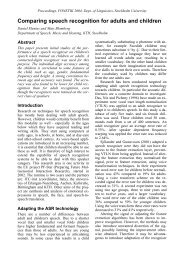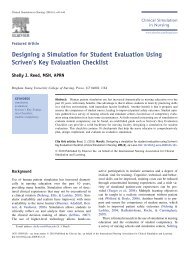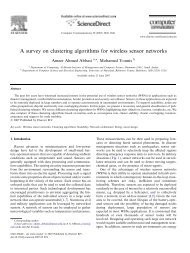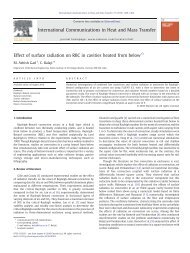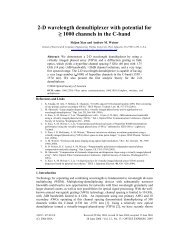Offline handwritten Arabic cursive text recognition using Hidden ...
Offline handwritten Arabic cursive text recognition using Hidden ...
Offline handwritten Arabic cursive text recognition using Hidden ...
Create successful ePaper yourself
Turn your PDF publications into a flip-book with our unique Google optimized e-Paper software.
1082 J.H AlKhateeb et al. / Pattern Recognition Letters 32 (2011) 1081–1088<br />
with quite a few state-of-art approaches. The main contributions<br />
which cover several key techniques proposed in our system can<br />
be highlighted as follows.<br />
(1) To design efficient pre-processing algorithms for baseline<br />
detection and word segmentation, where statistical analysis<br />
and knowledge-assisted decision making are employed.<br />
(2) With detected baseline, several structural features are<br />
extracted such as subwords, single/double/triple dots below<br />
the baseline and single/double dots above the baseline. From<br />
segmented words, a group of intensity features are extracted<br />
<strong>using</strong> a sliding window applied on mirrored word image.<br />
(3) To apply the above features for word <strong>recognition</strong> <strong>using</strong> a<br />
combined scheme, where intensity features are used to train<br />
a HMM classifier, whose results are further improved via reranking<br />
<strong>using</strong> extracted structural features. The re-ranking<br />
scheme is found to generate much improved results yet<br />
avoids multiple classifiers and additional non-visual features<br />
as used in other systems.<br />
(4) A quantitative measurement is defined to indicate how biased<br />
a test set is distributed, and this is further used for error analysis<br />
when results from different test sets are available.<br />
The remainder of this paper is structured as follows. Section 2<br />
describes the <strong>Arabic</strong> language while Section 3 presents literature<br />
review. Details of our proposed method in terms of pre-processing<br />
and feature extraction as well as classification are discussed in Section<br />
4. Comprehensive results are presented in Section 5, and the<br />
paper ends with conclusions and suggestions for further work in<br />
Section 6.<br />
2. The <strong>Arabic</strong> language<br />
Written by more than 250 million people, <strong>Arabic</strong> is one of the<br />
major worldwide document sources (Amin, 1998). With few similarities<br />
and many differences to written English, by its nature, <strong>Arabic</strong><br />
<strong>text</strong> is <strong>cursive</strong>, which makes its <strong>recognition</strong> more difficult than<br />
that of printed Latin <strong>text</strong>. On the other hand, <strong>Arabic</strong> writing, in a<br />
similar way to English, uses letters. The <strong>Arabic</strong> alphabet consists<br />
of 28 letters, and <strong>text</strong> is written from right to left in a <strong>cursive</strong><br />
way. Each <strong>Arabic</strong> letter has either two or four shapes depending<br />
on its possible position in the <strong>text</strong>, including start, middle, end, or<br />
alone (Amin et al., 1996; Abdulkadr, 2006). For example, the letter<br />
Ayn has the following shapes: start middle , end , and<br />
alone . The details of the letter shapes are illustrated in Table 1,<br />
and obviously this has brought more difficulty for automatic <strong>recognition</strong><br />
of <strong>Arabic</strong> <strong>text</strong>s.<br />
In addition, the <strong>Arabic</strong> language uses diacritical marking such as<br />
fattha, dumma, kasra, hamza(zigzag), shadda, ormadda. Using dots<br />
makes some <strong>Arabic</strong> letters special as follows (Amin, 1998; Lorigo<br />
and Govindaraju, 2006):<br />
Ten <strong>Arabic</strong> letters have one dot .<br />
Three <strong>Arabic</strong> letters have two dots .<br />
Two <strong>Arabic</strong> letters have three dots .<br />
Several <strong>Arabic</strong> letters include loop .<br />
The presence or absence of vowel diacritical indicates different<br />
meanings (Amin, 1998). For example: refers to college or kidney,<br />
and denotes love or seeds, and diacritical marking are<br />
essential to differentiate between possible meanings. However,<br />
the diacritical marking may be ignored in <strong>handwritten</strong> unless the<br />
words are isolated, and this introduces additional difficulty in<br />
our <strong>recognition</strong> task. As removal of any of these dots will lead to<br />
a misinterpretation of the character, efficient pre-processing tech-<br />
niques have to be used in order to deal with these dots without<br />
removing them and changing the identity of the character.<br />
There are six letters which are not connected from the left<br />
resulting in the separation of the word into sub-words or pieces<br />
of <strong>Arabic</strong> words (PAW) (Amin, 2000, Lorigo and Govindaraju,<br />
2006; Amin, 1998). Generally, the <strong>handwritten</strong> <strong>text</strong> is written on<br />
a page divided into lines which are further divided into words.<br />
There are spaces between the lines and the words. The spaces between<br />
the words define the word boundaries. Usually, the space<br />
between the sub-words is one third of the space between the<br />
words. This is done consistently in printed <strong>text</strong>, however, it varies<br />
in <strong>handwritten</strong> <strong>text</strong> and leads to inconsistency in segmentation of<br />
words and subwords (Amin, 2000).<br />
3. Literature review<br />
In (Khorsheed and Clocksin, 1999), words were recognised as a<br />
single unit depending on a predefined lexicon. In Stentiford’s algorithm<br />
(Parker, 1997), skeleton of words were used for word <strong>recognition</strong>,<br />
where structural features were extracted for <strong>recognition</strong> in<br />
three consecutive steps, including segment extraction, loop extraction<br />
and segment transformation. Using vector quantization (VQ),<br />
each feature vector was mapped to the nearest symbol in the codebook<br />
resulting in a sequence of observation to be fed into HMM. The<br />
technique was tested with a lexicon of 294 words acquired from different<br />
<strong>text</strong> sources, and a <strong>recognition</strong> rate of up to 97% was achieved.<br />
Khorsheed (Khorsheed, 2003) presented another holistic <strong>recognition</strong><br />
system for recognizing <strong>Arabic</strong> <strong>handwritten</strong> words, where<br />
structural features for the <strong>handwritten</strong> script were extracted after<br />
decomposing the word skeleton into a sequence of links with an<br />
order similar to the writing order. Using the line approximation<br />
(Parker, 1997), each line was broken into small line segments,<br />
which were transferred into a sequence of discrete symbols <strong>using</strong><br />
VQ. Then an HMM recognizer was applied with image skeletonization<br />
to the <strong>recognition</strong> of an old <strong>Arabic</strong> manuscript (Khorsheed,<br />
2000). The HMM was performed <strong>using</strong> 296 states on 32 character<br />
models, and each model was left to right HMM with no restriction<br />
jump margin. The system was tested on 12,960 <strong>recognition</strong> tests<br />
associated with 405 character samples of a single font extracted<br />
from single manuscript. The <strong>recognition</strong> rates achieved was 87%<br />
with spelling check and 72% if not.<br />
Pechwitz and Maergner (2003) presented an off-line system for<br />
the <strong>recognition</strong> of isolated <strong>Arabic</strong> <strong>handwritten</strong> words, where the<br />
IFN/ENIT dataset version v1.0p2 (Pechwitz et al., 2002), containing<br />
four sets (a–d), was used to valid their system. Pixel values from<br />
sliding windows were used as main features, along with Karhunen<br />
Loeve Transformation (KLT) for feature dimension reduction. The<br />
first three sets (a–c) were used for training and the remaining<br />
one for testing their Semi Continuous HMMs (SCHMM) classifier,<br />
and a <strong>recognition</strong> rate of 89% was achieved.<br />
SCHMM was also used in (Benouareth et al., 2006, 2008) for offline<br />
unconstrained <strong>handwritten</strong> <strong>Arabic</strong> word <strong>recognition</strong>. Statistical<br />
and structural features were utilized on the basis of the adopted<br />
segmentation in which implicit word segmentation was used to divide<br />
images into vertical frames of constant and variable width for<br />
feature extraction. Based on maxima and minima analysis of the<br />
vertical projection histogram, morphological complexity of <strong>handwritten</strong><br />
characters is further considered. Using the same dataset<br />
and under same experimental conditions, the <strong>recognition</strong> rate<br />
achieved with uniform segmentation was 81.02% for top 1 and<br />
91.74% for top 10. For non-uniform segmentation, the <strong>recognition</strong><br />
rate was 83.79% for top 1 and 92.12% for top 10, respectively.<br />
Similar strategy was also employed in another HMM-based system<br />
(El-Abed and Margner, 2007), where statistical features were<br />
length of skeleton in four directions extracted from five horizontal


